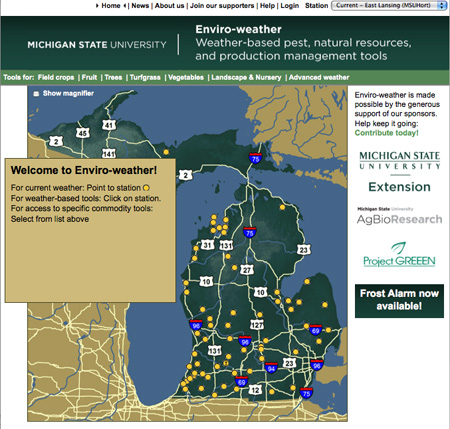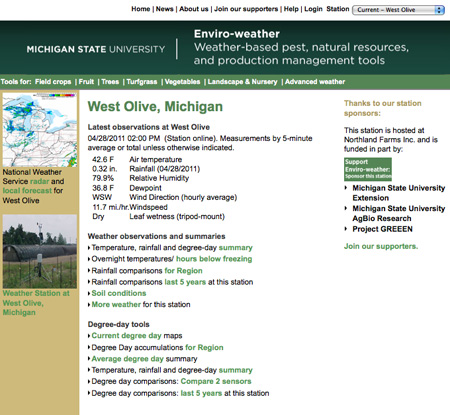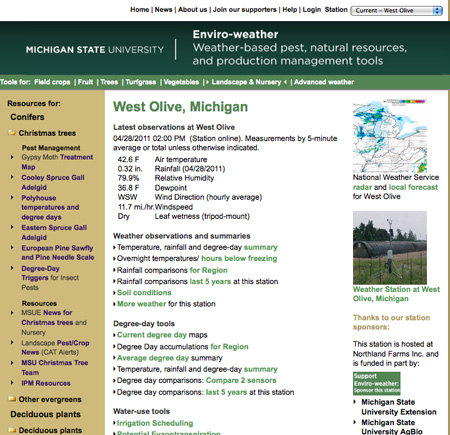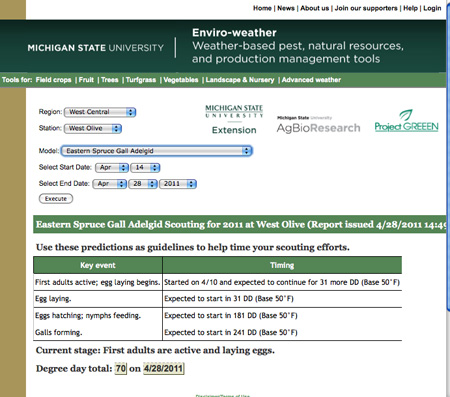New Enviro-weather tools help predict presence of damaging insect pests
Know when to scout for landscape, nursery and Christmas tree insect pests by using new Enviro-weather tools.
MSU’s Enviro-weather can now suggest the best time to look for damaging stages of several insect pests, such as Cooley spruce gall adelgid, pine needle scale and black vine weevil, among others. Enviro-weather uses weather data collected by its network of weather stations to create predictions of when to expect – and scout for – these insect pests.
Since insects are “cold-blooded,” their growth and activity depends on external temperatures. How much an insect develops is directly proportional to the amount of heat, over a certain “threshold,” that accumulates. Previous research has demonstrated that we can use the amount of accumulated heat, as measured by “degree-days,” to predict when various insect stages will occur. We’ve known the degree-day accumulations required for various pests of landscape and nursery for a while.
To confirm that these degree-day totals work to predict pest occurrence under Michigan conditions, MSU researchers and MSU Extension educators have collected data on the timing of various landscape and nursery pests and compared it to accumulated degree-days. As a result of several years of such work, we were able to develop specific pest prediction tools for Enviro-weather.
If you’d like to check out these new tools, first go to the Enviro-weather home page. You will see a map of Michigan with Enviro-weather station locations indicated by yellow dots (Photo 1).

Photo 1. Enviro-weather station locations are indicated by yellow dots.
Select the weather station closest to you by pointing at and clicking on the appropriate dot. You will be taken to the “station page,” which shows current weather conditions at that location (Photo 2). The station page also contains links to general-use tools (not specific to a particular commodity), such as weather and degree-day summaries. These tools use weather data collected by the selected station and, in some cases, nearby stations, and have a wide variety of uses for growers. You may want to explore what’s available.

Photo 2. The “station page.”
Tools and other applications for specific commodities can be accessed by clicking on the commodity tabs in the light green bar at the top of the page (“Tools for:”). Clicking on the “Landscape and Nursery” tab will take you to the “commodity page” that includes all information and tools available on the station page, plus tools for specific types of crops, which can be found in the left column. Clicking on a folder to the left of a crop type, such as “Christmas Trees,” opens that folder and displays specific tools available for that crop (Photo 3).

Photo 3. Tools for specific types of crops are found in the left column.
To try out one of the new pest prediction tools, just click on it. For example, if you click on “Eastern spruce gall adelgid” you will be taken to the page for this predictive tool (Photo 4).

Photo 4. Pest prediction tools.
The Eastern spruce gall adelgid page shows a table of “key events” in the lifecycle of the pest (left column), and the expected timing of these events (right column), based on data recorded by the weather station you select. At the bottom of the table, the current stage the pest is expected to be at, based on degree-day accumulations, is shown along with the current degree-day total.
As the season progresses and degree-day total accumulations increase, both the timing of the events and the current pest stage will change. If you’d like to get an idea of what the tool will look like as the season progresses, you can choose to use past weather data to calculate pest timing. Simply use the pull down menus near the top of the page to change the starting and ending dates and then click on the “execute” button.
The new tools available for nursery, landscape and Christmas tree growers include pest predictive models for: Cooley spruce gall adelgid, Eastern spruce gall adelgid, European pine sawfly, pine needle scale, gypsy moth, euonymous scale, fletcher scale, black vine weevil, cottony maple scale, and magnolia scale.
We hope you will find these new insect predictive tools useful and we are continually looking to improve them. We want to hear from you! If you have questions, comments, complaints, suggestions or compliments, please share them with us. I can be reached at bishopb@msu.edu,eweather@msu.edu, or 517-432-6520.



 Print
Print Email
Email

